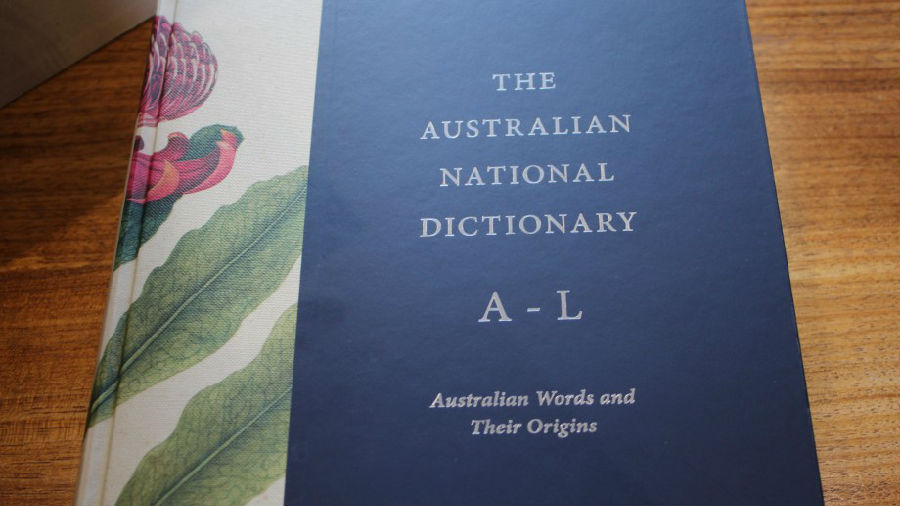


ANU completes work on new edition of the Australian National Dictionary
A new edition of the Australian National Dictionary has just been published. It contains 16,000 words and while the first edition (published in 1988) included about 250 words from 60 Aboriginal and Torres Strait Islander languages, the latest has more than 500 words from 100 languages.
Conventional wisdom has it that borrowings of this kind usually occur in the initial "contact" period. In 1770, for instance, James Cook and Joseph Banks collected the word kangaroo from the Guugu Yimithirr language in the area now known as Cooktown in Queensland, and it immediately came into use in English.
Soon after the initial batches of convicts arrived in Sydney from 1788 onwards, words from local languages were taken up, especially for new flora and flora and for things associated with the Indigenous people: koala, wallaby, kurrajong, waratah, woomera, corroboree. Later, the language of the Perth area provided jarrah, kylie (a word for "boomerang"), numbat, and quokka. The language of the Geelong area provided the mythical monster the bunyip.
Some Aboriginal words, although noted in the early period, were not used widely in Australian English until much later. Perhaps the most startling example of this is the word quoll, which comes from the Guugu Yimithirr language, and was also collected by Cook and Banks in 1770. When the Europeans arrived in 1788, they did not use quoll or other Indigenous names for these marsupials. Instead, they used the term native cat, preferring to construct terms based on superficial resemblances to things of their "known" world. It wasn't until the 1960s that quoll was reintroduced, and eventually replaced native cat, largely due to the efforts of the naturalist David Fleay, who highlighted the absurdity of some of the vernacular names for Australian animals.
Many of the new Aboriginal words in this edition refer to flora and fauna, and many of these result from an interest in using Indigenous names rather than imposed English descriptive ones. Thus, the southern and northern forms of the marsupial mole are now referred to by their Western Desert language names itjaritjari and kakarratul. The rodent once called the heath mouse is now known by its indigenous name dayang, from the Woiwurrung language of the Melbourne area. The amphibious rodent formerly known as water rat, is now more commonly referred to in southern Australia as the rakali, from the Ngarrindjeri language.
Other additions to the dictionary include (from the Noongar language of the Perth area) balga for the grass tree, coojong for the golden wreath wattle, moitch for the flooded gum and moort for Eucalyptus platypus.
The increasing interest in bush tucker has meant the inclusion of akudjura for the bush tomato, from the Alyawarr language of the southern region of the Northern Territory, and gubinge, from Nyul Nyul and Yawuru of northern Western Australia, for an edible plum-like fruit.
Other new terms reflect a renewed interest in aspects of Aboriginal and Torres Strait Islander culture and various kinds of activism on the part of Indigenous peoples. They include bunji, "a mate, a close friend a kinsman" (from Warlpiri and other languages of the Northern Territory and northern Queensland), boorie, "a boy, a child" (from Wiradjuri), jarjum, "a child" (from Bundjalung), kumanjayi, "a substitute name for a dead person" (from Western Desert language), pukamani "a funeral rite" (from Tiwi), rarrk "a cross-hatching design in art" (from Yolngu languages), tjukurpa, "the Dreaming; traditional law" (from Western Desert language) and yidaki, "a didgeridoo" (from Yolngu languages).
The word migaloo - "a white person" - comes from Biri and other northern Queensland languages, where it originally meant "a ghost, a spirit"; many Australians are familiar with this word as a name for the albino humpback whale that migrates along the east coast of Australia.
Many of these terms begin their transition to mainstream Australian English in forms of Aboriginal English, and some of them are primarily used in Aboriginal English. In addition to the words from Indigenous languages, there are numerous terms new to the dictionary that render Indigenous concepts and aspects of traditional culture, formed from the resources of English. These include such terms as: carved tree, dreamtime being, freshwater people, keeping place, law woman, paint up, saltwater people, secret women's business, smoking ceremony, songline, sorry business, welcome to country.
Others derive from more specific political contexts and political activism: Day of Mourning, great Australian silence, Invasion Day, Mabo, tent embassy, traditional ownership and white blindfold ("a view of Australian history that emphasises the achievements of white society and ignores Aboriginal society").
This is a dictionary based on historical principles. This means that each entry maps the full history of a word, establishing its origin, and documenting its use over time with illustrative quotations from books, newspapers, and the like. Words and meanings are included if they are exclusively Australian, or used in Australia in special or significant ways.
The dictionary, edited at the Australian National Dictionary Centre at the Australian National University, and published by Oxford University Press, was recently launched at Parliament House in Canberra, Australia.
You can get more information about this fascinating book here:
http://www.anu.edu.au/news/all-news/do-you-know-a-bunji-from-a-boorie-meet-our-dictionarys-new-indigenous-words